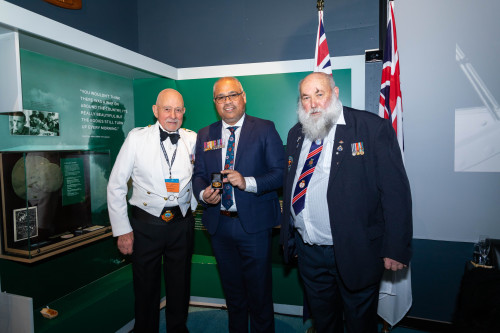Commemoration of 50 years since HMNZS OTAGO sails to protest French nuclear tests
Commemoration of 50 years since HMNZS OTAGO sails to protest French nuclear tests
It was recently the 50th anniversary of New Zealand’s protests against nuclear testing in the Pacific.
The Mururoa Nuclear Veterans Group Inc. hosted a commemoration of 50 years since the Mururoa deployments. Their first event was at the Museum of the Royal New Zealand Navy, Devonport, on 7 July. Speakers included the Minister for Veterans the Hon Peeni Henare, Sir Wayne Shelford President of the RNZRSA, and Deputy Chief of Navy Commodore Andrew Brown.

Pete Elboum, Hon Peeni Henare Minister for Veterans, Gavin Smith, President, Mururoa Nuclear Veterans Group.
Following the Second World War, the Pacific was a regular atmospheric testing ground for the nuclear programmes of the United States, Britain and France. In 1963, The US, UK and Soviet Union were signatories to a partial test ban treaty that sought to halt atmospheric testing but allowed for underground testing. France refused to sign the treaty.
By 1966, France had begun atmospheric nuclear testing in French Polynesia. Mururoa Atoll had become the main location for these tests, and there was increasing concern amongst Pacific nations of them.
During the 1972 New Zealand election campaign, the Labour Party, headed by Norman Kirk, had indicated their intention to send a frigate, with a cabinet minister aboard, to Mururoa to further the protest if they won the election. On 25 November, Kirk led Labour to victory with a majority of 23 seats.
Almost immediately, Royal New Zealand Navy staff began working on an operational plan for two frigates to be tasked to Mururoa. While a RNZN-led mission, the Royal Australian Navy lent the tanker HMAS SUPPLY to provide refuelling services, and the Royal New Zealand Air Force and Royal Australian Air Force airlifted supplies to Rarotonga for ship replenishment.
On 28 June 1973, HMNZS OTAGO, with 242 crew and the Hon. Fraser Colman, Minister of Immigration and Mines, made the 4,700-kilometre sail from the Devonport Naval Base to Mururoa to protest the next series of tests scheduled for July.
Throughout the tasking, the French Navy’s Lockheed Neptune maritime patrol aircraft flew various patterns, fully testing OTAGO’s radar, electronic warfare and IFF passive and active capabilities. On 21 July, a nuclear device was detonated at just over 1,000 feet. HMNZS CANTERBURY rendezvoused with OTAGO the following day and witnessed another detonation on 28 July.
The pressure brought about by the New Zealand Government protest, and mounting worldwide criticism, caused France to abandon atmospheric testing in 1974 and move to underground testing. A further 149 underground nuclear tests were to be conducted at Mururoa Atoll by France until their last one in January 1996.
